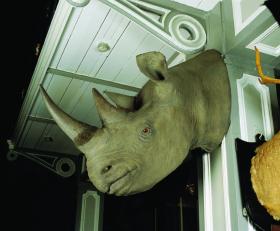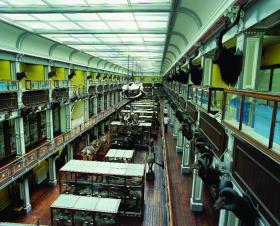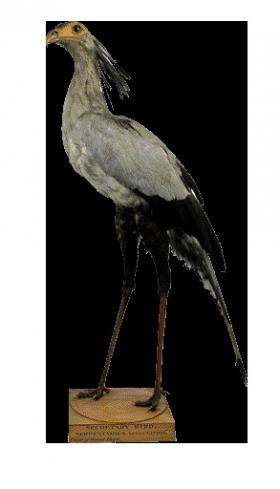Museum Eye
Published in Issue 4 (Jul/Aug 2006), Reviews, Volume 14
Head of black rhino, Kenya.
Natural History Museum
(National Museum of Ireland)
Merrion Street, Dublin 2
www.museum.ie
Tues–Sat 10am–5pm, Sun 2–5pm
by Tony Canavan
The Natural History Museum is something of a museum piece in itself, harking back to an era when there was a completely different attitude to wildlife and the environment. The internal architecture of the building is an echo of another century and has not changed much since it opened in 1857. Inside, the stuffed animals and skeletons in glass cabinets, mounted like trophies of the hunt, add to the impression of a timewarp. The National Museum recognises this and advertises it as a ‘museum of a museum’, making a virtue of this Victorian fossil.
The museum too is a concrete reminder of Ireland’s involvement in the British Empire. While Ireland as a state may not have played a role, countless Irish people participated in the conquest and colonisation of those territories. The Royal Dublin Society (RDS), whose museum this originally was, was part of the intellectual community that not only studied but also helped to administer Britain’s colonies. The exhibits in the museum, from the smallest insect to the largest skeleton, are all testimony to the eagerness of donors from across the empire to contribute to the work of the RDS.
So, intellectually or morally the Natural History Museum presents a double dilemma—environmental and imperial—in terms of what it stands for. ‘Official Ireland’ presents the Irish as victims rather than perpetrators of empire, and the museum does not attempt to address the context in which animals were slaughtered on imperial hunting-grounds so that it could have its exhibits. It is such a complex and problematic issue that we should not be surprised.
However, the museum does to some degree address the environmental issue. Alongside the older information labels there is the occasional modern label that contrasts past and present attitudes to wildlife. For example, an older label next to the tusk of an African elephant proudly proclaims that it was ‘shot by Dr G. S. Pownall in Uganda, East Africa, one of the largest tusks ever obtained—weight 176lbs’, but an accompanying label is much more apologetic for the damage done in collecting such specimens and explains how modern African elephants are threatened by poachers. One of the worksheets for children is entitled ‘The Extinction Trail’ and leads the visitor to preserved specimens of species that are extinct or facing extinction.

General view of the upper floors.
Yet such issues do not seem to concern the visitors, although some might baulk at the sight of stuffed five-day-old lion cubs at their mother’s feet. During my visit the museum was full of people of many nationalities and all age groups. It is a popular place, and people were as eager to see stuffed specimens of our own wildlife on the ground floor as the creatures from around the world on the upper floors. Families were much in evidence and it was interesting to see children’s reactions. One child stood before a cabinet of African wildlife, identifying the lions, meercats etc. as characters from The Lion King. Another declared in a tremulous voice, ‘It’s scary, Mammy!’, while a little girl nearby was being assured by her father that the great apes were not dead, just asleep.
At the risk of making a bad joke, the museum is a lively place, not just full of visitors but also of activities. There are various themed tours that any visitor would be wise to go on in order to learn more about the exhibits and how they got there. There are also workshops on different aspects of the museum’s work, such as taxidermy and drawing skills for Leaving Cert students. There were a number of people sketching specimens during my visit.
The museum promises to present everything from aardvark to zebra and this is true. There are row upon row of cabinets full of all sorts of creatures, from insects and fish to mammals and birds. There is a strong African element among the overseas creatures, with stuffed animals such as lions, cheetahs, hyaenas (sic) and the aardvark. Another case displays monkeys of all shapes and sizes, from the mandrill to the baboon. The only stuffed elephants are Indian, but the African is represented by the aforementioned tusk and skeletal remains. The zebra is there too, as are the heads of numerous kinds of gazelle and antelope, further souvenirs of the hunt. Smaller rodents have their place, from the East African mouse to various kinds of bat.
While the elephant, hippopotamus or giraffe may impress or even overawe, I think the most poignant exhibits for the modern visitor are the ‘anthropoid apes’. We know so much more about these animals than ever before, and the knowledge that we share so much of our genetic make-up with them—95 per cent in the case of the chimpanzee—means that the visitor today gives greater significance to these creatures than did visitors of a century ago, who would have viewed them simply as dumb beasts. There are two cabinets and before each I saw visitors halt and speak in hushed tones, commenting on the impression of power and intelligence that still emanates from their lifeless forms. The second cabinet is particularly impressive as it contains the skeletons of a gorilla, a chimpanzee, an orangutan and a human. Stripped of flesh, the similarity between ape and human is particularly striking.

Secretary bird, Cape of Good Hope, South Africa.
Yet you would do well also to visit the other floors, where you can see smaller animals, birds, insects and beautiful glass models of sea creatures. Many of the preserved specimens of insects are so delicate that the cabinets are kept under a cover, which you lift to reveal magnificent moths and butterflies, menacing spiders and scorpions, and monstrous beetles and crustaceans.
It may be lack of resources that keeps this museum unchanged but I think that the National Museum is right to preserve it as a specimen of a bygone age. It is educational for us to see what the word ‘museum’ meant in the nineteenth century, and the objects on display continue to have a fascination for young and old alike. For the young it may be the thrill of the spectacle, while the older visitor will not only learn something about the creatures but also ponder the museum’s troubling legacy.
Tony Canavan is a former Museum Officer of Newry and Mourne District Council.
















